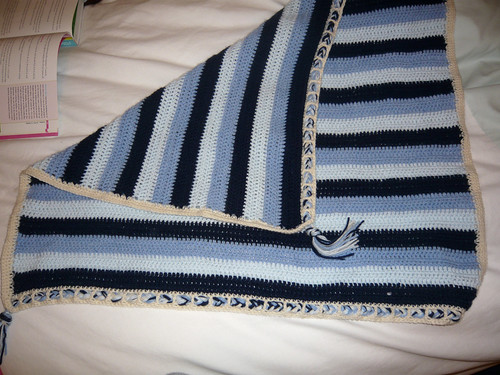This isn’t a new book – in fact it’s about three years old, but it’s new to me. I got it as a birthday present just a couple of weeks ago.
The book starts with an introduction from Chan – why she crochets, her theory of ‘exploded’ lace and a bit of advice on how best to approach the patterns. Then it’s the usual abbreviations and stitch keys and then straight into the patterns. There are 19 of them in total, arranged into four chapters with names like Garden Party and Last Call, which seem to have more to do with the names of patterns rather than the look of any of the garments.
First things first, then, exploded lace means taking a pattern for some small decorative item – like a doily or table runner – and adapting it for bigger yarn, bigger hooks and a much, much bigger product, like a shawl, a t-shirt or a dress.
Chan also talks about every crocheter’s most hated stage – the foundation chain. She uses something she calls the BASE CH/SC. It involves making two chains and making both a chain and a single crochet into the first chain. Then doing the same into the chain of the stitch you just made, and repeating this till you’ve got the right number of stitches. It’s something I’ve never encountered before and the instructions and illustrations really are clear. With a bit of practice it was pretty simple. The resultant chain is an odd-looking bulky thing that is remarkably easy to crochet into. I’m not sure it’ll take over from a traditional chain in my crochet repertoire, but it’s certainly good to know.
The pattern I tested was Chrysanthemum Tea Shawl, a huge circular shawl adapted from three doily patterns. The instructions are easy to follow and the thick yarn and big hook mean the piece grows pleasingly fast. Each pattern comes complete with full written instructions and chart showing a sample of the lace pattern.
The garments, which include a skirt, a dress, t-shirts and shawls, are all lovely, with only a couple I wouldn’t wear. The layout and instructions are generally good, clear and simple to follow. But make no mistake, these pieces are not for the beginner. The patterns are complex, often involving hundreds of stitches. To do this you need the time and space to concentrate – don’t do what I did and sit down in front of Smallville and think it’ll turn out OK. It won’t. And make sure you check for errata before you start. I found a mistake in the special stitches box! But think how much worse it would be to have completed a few hundred stitches only to realise something’s wrong.
One problem is the photography. Each garment has a full-page plate and often another couple of photos. But these are all dark, making it difficult to see colours and detail. A little lightening in Photoshop would have helped. But this really is a minor niggle in an otherwise excellent collection.
A couple of not-very-good shots of the shawl.

